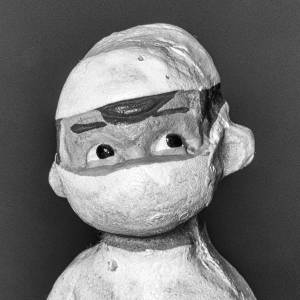Mono-Monday: "Diamond" - Molecular Structure
Today’s Mono-Monday topic is “Diamond” in recognition of the fact that it is the birthstone for April (see here).
This is a model of the crystalline structure of diamond – it was given by to my parents by one of our sons on the occasion of their diamond wedding 10 years ago.
Diamond is a form of very pure carbon where the atoms are arranged in a very orderly lattice-type crystal structure. If you can remember your school chemistry, you’ll know that carbon has a "valency" of 4. It has 6 electrons in each atom, 2 in the inner “shell” and 4 in the outer shell. Because the outer shell “likes” to have a full complement of 8 electrons in it in order for the substance to be stable, each atom likes to “share” an electron with each of 4 neighbouring atoms so that they all “think” they have 8 electrons in their outer shells - hence the valency of 4. The sharing of an electron in this way is known as a "covalent bond", and it serves to hold the atoms together. In carbon, there are various ways in which these covalent bonds can be arranged, producing a variety of forms of carbon. (In the model, the atoms are represented by black balls and the bonds by grey rods.) The way they are arranged in diamond makes it the hardest of all bulk materials. Indeed, the name “diamond” comes from an ancient Greek word meaning “unbreakable”.
As a consequence diamond has found many uses in industry, especially for cutting and polishing equipment. During my career as an eye surgeon I often used tiny knives with a sharpened diamond tip to make precise and very neat incisions, and they would stay sharp for ages - until someone dropped them anyway, preferable not on the surgeon's foot! It is also used in record-player styli to ensure a long life for the needle. As everyone knows it is also widely used in jewellery as a consequence of its stunning optical properties when cut in a certain way - it's usually used as a colourless material but it's sometimes found in a coloured state when it contains small amounts of impurities which can give diamonds a specific colour (eg boron makes them blue).
Most natural diamonds are formed at high temperature and pressure at depths of 140 to 190 kilometers (87 to 118 mi) in the Earth's mantle, where their growth occurs over periods from 1 billion to 3.3 billion years. They are brought nearer the surface by volcanic eruptions. Diamonds can also be produced synthetically using a technique which approximately simulates the conditions in the Earth's mantle.
(Information condensed from Wikipedia.)
I hope you all have fun dreaming up your Mono-Monday blip. You'll probably be glad that this is my last week of hosting as I gather some folks have found my topics tricky although you've come up with some splendid interpretations so I'm not feeling too guilty :-)
Please feel free to interpret "Diamond" as broadly as you like - I think that's part of the fun. But equally well, I'm perfectly happy to see lots of photos of different actual diamonds - they're all unique and are so pretty. And please tag your entries MM118. I’m really looking forward to seeing all your interpretations of the theme; I’ll announce my Hearts and Honourable Mentions on Wednesday or Thursday.

Comments
Sign in or get an account to comment.


